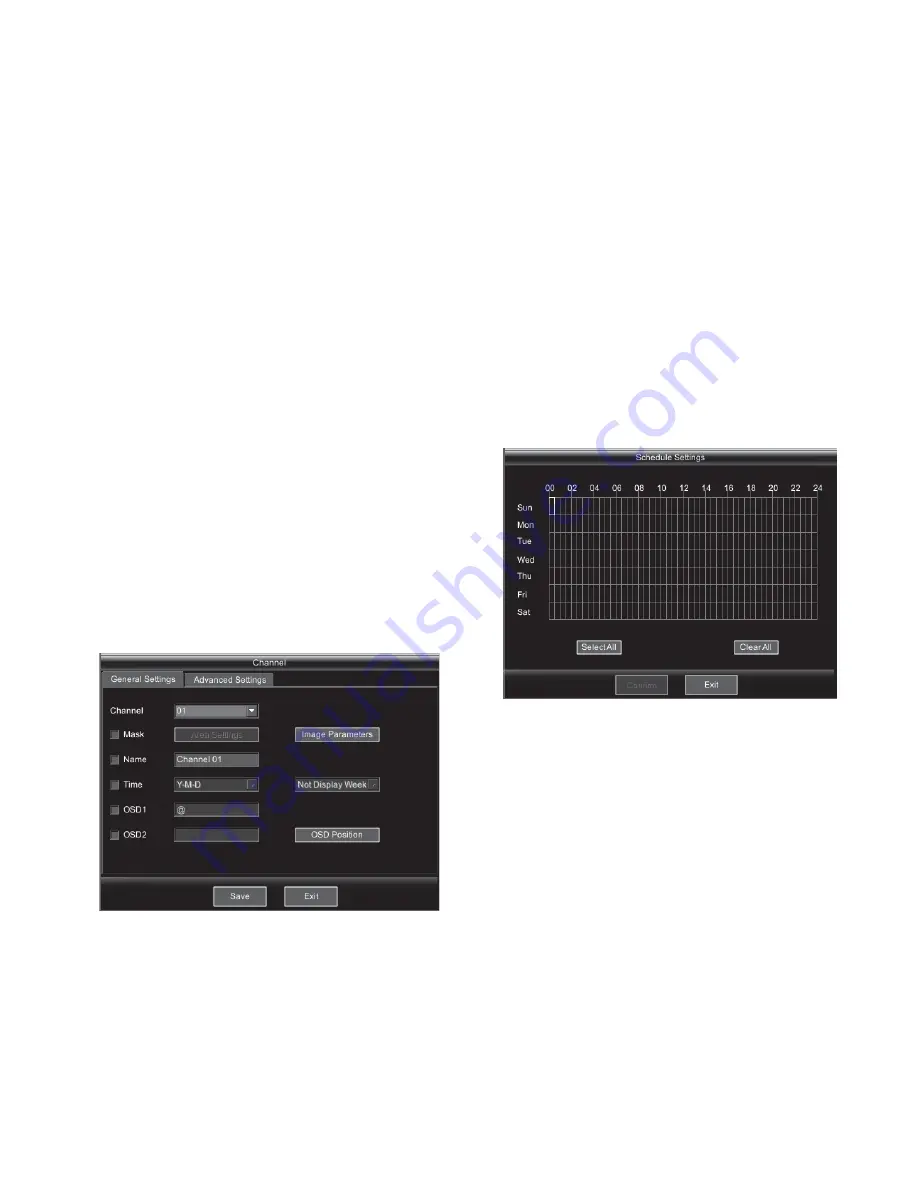
17
"Start" button, and press
Ǐ
ENT
ǐ
key, now on the screen there will
be a message to indicate the pattern is ready to set, such as SET
PATTERN XXX". Move the cursor to the direction keys, and press
Ǐ
ENT
ǐ
key to confirm the movement direction. After finishing
setting, move the cursor to "Stop" button, and press
Ǐ
ENT
ǐ
key to
stop and save the pattern setting.
2. Call pattern
In the interface as shown in Figure 4-5, input the pattern number,
for example 1, press "Call", and then the pattern 1 is called.
Note
: The pattern could be called up by calling presets, and the
method varies from different domes or pan/tilt, please refer to the
manual of dome and pan/tilt for details. For example, for the domes
or pan/tilt cameras with Infinova protocol, the pattern 1 to 4 could
be called by calling up preset 70 to 73.
4.5 Alarm
The DVR supports three different types of alarm, channel, input and
abnormity alarm.
4.5.1 Channel Alarm
The channel alarm includes video mask alarm, video loss alarm and
motion detection alarm.
It will generate alarm if there's video mask in that channel
It will generate alarm if there's video loss in the setting channel;
It will generate video motion detection alarm and linkage if there's
motion detection.
Enter the channel setting from the "Channel" in the main menu,
press
Ǐ
WIDE
ǐ
key to switch to "Advanced Settings" option, as
shown in Figure 4-6.
Figure 4-6
Below section has detailed introduction on the setting and method
for the three different types of alarm.
1. Video mask alarm
As shown in Figure 4-6, press
Ǐ
ENT
ǐ
key to call out the
drop-down list to select the desired channel, and press
Ǐ
ENT
ǐ
key
to confirm the selection. Select the video mask option, and press
Ǐ
ENT
ǐ
key to enable it, and allow mask alarm setting (sensitivity,
area, schedule time, linkage). The "mask alarm" option will
disenable when press the
Ǐ
ENT
ǐ
key if it's selected.
(1)
Set sensitivity
The default sensitivity is medium. Press
Ǐ
ENT
ǐ
key to call out list
after move the cursor to the "Sensitivity" option, and select the
desired sensitivity level, and then press
Ǐ
ENT
ǐ
key. Three levels
are available, high, medium and low.
(2)
Set area
Press
Ǐ
ENT
ǐ
key to enter area setting menu after selecting "Area"
option. Press
Ǐ
IRIS+
ǐ
key to enable the cursor. Move the area
position via
Ǐ
ǐ
,
Ǐ
ǐ
,
Ǐ
ǐ
and
Ǐ
ǐ
keys. Press
Ǐ
ENT
ǐ
key to enter the editing status of the size of box, and set the size of
the box via
Ǐ
ǐ
,
Ǐ
ǐ
,
Ǐ
ǐ
and
Ǐ
ǐ
keys, press
Ǐ
ENT
ǐ
key to confirm. After press
Ǐ
ENT
ǐ
key , the next box will pop up
automatically, press
Ǐ
ESC
ǐ
key to exit and save the setting.
Note:
In the area setting status, press
Ǐ
*
ǐ
key to select all the area,
and
Ǐ⬄ǐ
key to clear all area. In this system, the full screen area is
regarded as the mask alarm area regardless its size.
(3)
Set schedule
Move the cursor to "Schedule" option and press
Ǐ
ENT
ǐ
key to enter
"Schedule Settings" interface, as shown in Figure 4-7.
Figure 4-7
In the interface, move the cursor (the white bar) to the desired
schedule time, and press
Ǐ
ENT
ǐ
key, then the area selected will
turn to green. Press
Ǐ
ESC
ǐ
key to exit.(The focus will go to "Select
All" button.)
Press "Confirm" to save the schedule time setting. Press "Exit" to
return to "Channel" interface.
(4)
Set alarm output
Move the cursor the "Output" option of video mask alarm, and
press
Ǐ
ENT
ǐ
key to enter alarm output setting interface, as shown
in Figure 4-8.
Summary of Contents for V3060 Series
Page 6: ......






























